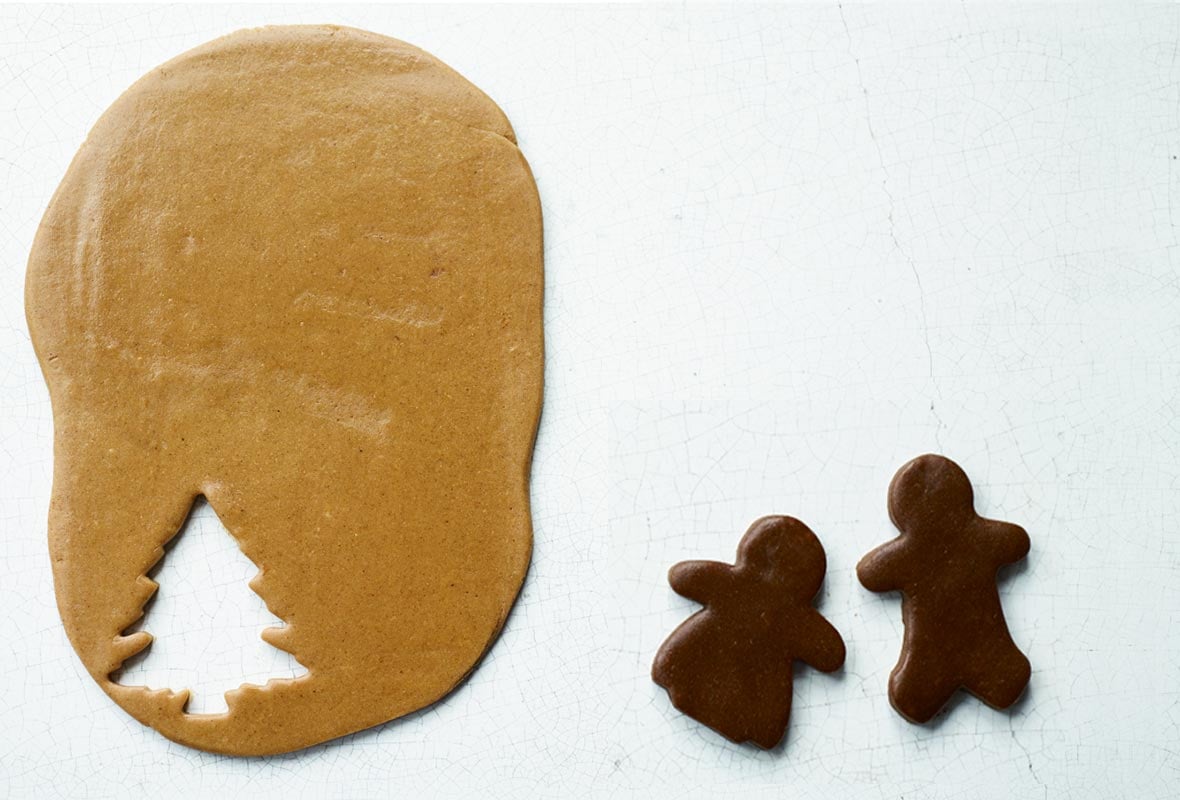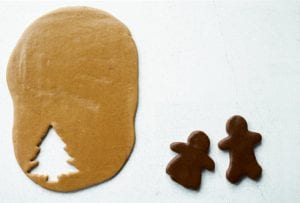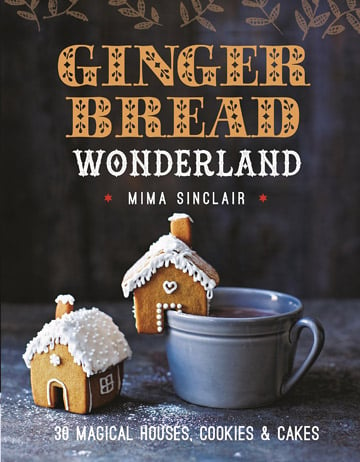
That’s correct. This recipe makes light and dark gingerbread cookies. Because sometimes it’s not a bad thing to indulge our culture of gratification and have exactly what we want. In this case, it’s exactly the gingerbread cookie you crave, whether that means the light gingerbread cookie that’s mild and sweet and light in color or the dark gingerbread cookie that’s stronger, spicier, and visually more arresting owing to the inclusion of dark molasses. One isn’t inherently lovelier than the other. Just different.–Renee Schettler

Light and Dark Gingerbread Cookies
Ingredients
For the light gingerbread cookie dough
- 1/2 cup light molasses, golden syrup, or honey*
- 1 cup light brown sugar
- 3/4 cup plus 2 tablespoons unsalted butter
- Finely grated zest of 1 lemon (about 1 tablespoon)
- 4 teaspoons ground ginger
- 2 teaspoons ground cinnamon
- 1/2 teaspoon ground nutmeg
- 1/4 teaspoon ground cloves
- 1 teaspoon baking soda
- 4 cups all-purpose flour
- 1 teaspoon salt
- 1 large egg, lightly beaten
For the dark gingerbread cookie dough
- 1/4 cup dark molasses (blackstrap molasses)
- 3 tablespoons light molasses, golden syrup, or honey
- 1 cup dark brown sugar
- 3/4 cup plus 2 tablespoons unsalted butter
- Finely grated zest of 1/2 orange
- 4 teaspoons ground ginger
- 2 teaspoons ground cinnamon
- 1/2 teaspoon ground nutmeg
- 1/4 teaspoon ground cloves
- 1 teaspoon baking soda
- 4 cups all-purpose flour
- 1 teaspoon salt
- 1 large egg, lightly beaten
Instructions
Make the light gingerbread cookie dough
- In a large, deep-sided saucepan over medium-low heat, combine the light molasses, sugar, butter, lemon zest, and spices and cook, stirring frequently, until the sugar dissolves, about 5 minutes.
- Increase the heat to medium high and bring the mixture to a boil. Remove from the heat and vigorously beat in the baking soda. Be careful as the mixture will froth up. Mix briefly just until combined and then let cool for 15 minutes.
- In a medium bowl, sift together the flour and salt and then fold it into the mixture in batches, using a wooden spoon or a stand mixer. Beat in the egg until just combined. Do not overwork the mixture or the cookies will spread during baking. The dough will be very sticky.
- Scrape the dough onto a clean surface and knead until just smooth, about 7 minutes. Do not add any flour. (Alternately, you can use the dough hook on a stand mixer and knead for about 5 minutes.) Wrap the dough in plastic wrap and place it in the fridge for at least 1 hour and up to 48 hours. (You may need to let the dough rest at room temperature for 10 to 20 minutes prior to being able to roll it.)
Make the dark gingerbread cookie dough
- Meanwhile, in a large, deep-sided saucepan over medium-low heat, combine the dark and light molasses, sugar, butter, orange zest, and spices and cook, stirring frequently, until the sugar dissolves, about 5 minutes.
- Increase the heat to medium high and bring the mixture to a boil. Remove from the heat and vigorously beat in the baking soda. Be careful as the mixture will froth up. Mix briefly just until combined and then let cool for 15 minutes.
- In the bowl of a stand mixer, sift together the flour and salt and then add the baking soda mixture in batches. Beat in the egg until just combined. Do not overwork the mixture or the cookies will spread during baking. The dough will be very sticky.
- Use the dough hook on your stand mixer to knead the dough for about 5 minutes or scrape the dough onto parchment paper and knead until just smooth, about 7 minutes. The dough will be quite sticky as you start to knead but do not add any flour. Wrap the dough in plastic wrap and place it in the fridge for at least 1 hour and up to 48 hours. (You may need to let the dough rest at room temperature for 10 to 20 minutes prior to being able to roll it.)
Roll out and bake the gingerbread cookies
- Preheat the oven to 325°F (163°C). Adjust the oven rack to the center position. Cut a large piece of parchment paper.
- On a large sheet of parchment paper, roll out the gingerbread dough to a thickness of 1/4 inch (6 mm). Use cookie cutters or gingerbread house templates to cut shapes. Leaving the dough on the parchment, carefully transfer everything to a rimmed baking sheet. Gather any scraps of gingerbread cookie dough and either roll them out on a second piece of parchment paper and make more shapes or wrap the dough in plastic wrap and refrigerate it for another day. (Never throw away scraps of gingerbread cookie dough!) Place the baking sheet with the gingerbread cookie dough in the freezer for 10 minutes.
- Bake in the oven in batches until the cookies are golden brown at the edges, 10 to 20 minutes for smaller pieces and 20 to 25 minutes for larger pieces. (The longer the baking time, the stiffer the gingerbread cookies, so if you are constructing a gingerbread house or something similar that requires support, bake the cookies until a little more golden than you might usually bake a cookie. The oven temperature in this recipe is intentionally lower than many cookie recipes to help the dough hold its shape well and for the cookies to bake through entirely without over browning the surface.) Let the gingerbread cookies cool for 5 minutes on the baking sheet, then carefully transfer to wire racks to cool completely. You can keep the gingerbread cookies at room temperature in a covered container for up to several days. Click here for more information on storing and freezing your cookies. If constructing a gingerbread house, it will keep at room temperature for up to 2 weeks if kept out of direct light and in a cool, dry environment.
Notes
What You Need To Know About Honey In Cookies
Just sharing a word of caution from the author that if you opt to use honey in cookie dough, it can cause the cookies to spread a little during baking. Just thought you should know in case you’re seeking cookies that have super precise and straight lines.
Explore More with AI
Nutrition
Nutrition information is automatically calculated, so should only be used as an approximation.
Recipe Testers’ Reviews
Perfect gingerbread cookies recipe! Your house will smell wonderful, too! I kneaded the first batch of dough by hand for 7 minutes and it was a total mess. The dough is VERY sticky at this point and I ended up with giant gingerbread hands. For the second batch, I used my dough hook on the mixer for 5 minutes and it was fine. Freezing the gingerbread cookie dough for 10 minutes is the secret to keeping the pieces from spreading while baking. The larger pieces baked for 22 minutes and even the smaller ones baked for 15 to 20 minutes. Every piece came out perfectly.










David,
Thank you for all of the detective work. After reading comments and your emails, I’m going to try Dutch process cocoa. I’m curious about whether I should do a full 1/2c, and if because of its alkaline nature I need to add baking powder to the recipe since Dutch process respond to baking soda. Any thoughts?
Kristen, I think it’s best to add the cocoa and see how that goes. It’s hard to determine what makes the difference if there are more than one variable being changed.
I clicked on your email, and tried to send my number, but got a failed email notification. I’ll try again. Thank you.
It’s david@leitesculinaria.com. Copy that, and put it into your email application. That should work!
I looked back at my earlier onversation from 2021, when the recipe for dark gingerbread used to say “full flavor” molasses. The person who answered me admitted that “black treacle” was used in the original recipe, and that is the UK’s equivalent of blackstrap. Three years have passed…I finally got an enormous jug of blackstrap (unsulphured) as advised, and there is really no change in the outcome of the cookies. Now I’m really suspicious….are the photos of the dark and light cookies just stock photos? I cannot for the life of me figure out what is going on. I’ve baked gingerbread for 15 years, at least. And even a beginner, with the blackstrap molasses, should get dark gingerbread….so I’m super confused as well as discouraged that my gingerbread dreams are not coming true. 🙂
Kristen, something is definitely wrong here. I checked the original recipe, and what we have on the site is exactly the same as the recipe in the cookbook. The photo is taken from the cookbook; it’s not a stock photo.
I’ll do my best to troubleshoot this with you, but I think this should be taken off-line and continued on a phone call. If you can email me at david@leitesculinaria.com, and give me your telephone number, I will call you.